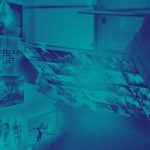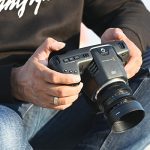A Dubai-based production team created a special rig for a POV shoot with the Blackmagic Pocket Cinema Camera for a promo. Director Omar Abbas gives us an exclusive first-hand account of his experience filming with the camera The shoot Alchemy Films, a Dubai-based production house, contacted me to work on and direct its latest project, […]
A Dubai-based production team created a special rig for a POV shoot with the Blackmagic Pocket Cinema Camera for a promo. Director Omar Abbas gives us an exclusive first-hand account of his experience filming with the camera

The shoot
Alchemy Films, a Dubai-based production house, contacted me to work on and direct its latest project, a viral commercial series for a new Latin American Supper Club called Izel. Ad agency Saatchi & Saatchi had conceptualised a campaign that required a first-person perspective throughout the set of four commercials. The scenarios had a lot of potential, and since they
were intended for online purposes, we were able to push the boundaries and make the films a lot of fun. It was particularly exciting to learn that this would be one of the first POV shoots ever done using the Blackmagic Pocket Cinema Camera.
In the final films that we developed, everything is seen from the perspective of a CEO, who has the habit of flashing back at the most inappropriate times to memories of being at Izel with a beautiful woman, who represents the spirit of the club.
A hapless young employee accompanies the daydreaming CEO as he comes in and out of these flashbacks. He is the character, whom we see the most in front of the camera, as he bears the brunt of the CEOs altered state. Whenever the CEO comes back from a daydream, he is doing something out of character to the employee, who has no choice but to take it like a champ.
The camera
The reason I chose the Blackmagic Pocket Cinema Camera is because of its size, the quality of the brand, its file format, and its novelty in the market. As soon as I knew we would be doing everything in first-person (point-of-view or POV), I called my friend Andrew Clemson, who owns one of the first pocket camera units in the country, to help me shoot the films.
In terms of its size, the pocket camera is miniscule. Its essentially as big as a consumer stills camera. This came in handy when building the first person POV rig.
Coming from Blackmagic, I knew that the brand would carry with it the standard that I could depend on for a professional shoot, even though the camera body is deceptively small.
The cameras file format is ProRes422 or CinemaDNG RAW, which meant easy editing and a wide dynamic range for grading. The pocket camera didnt record RAW at the time of the shoot so we were limited to ProRes 422HQ, and we recorded in log, so as to maximise the grading capabilities in post. Basically, it offered the same settings as we would record on quick turnaround Alexa jobs. Most of the time, we were at ASA800, but for the darker club scenes we pushed to 1600ASA.
The cameras uniqueness in the market is something that intrigued me as well. Its important for filmmakers to make use of the latest available technology to keep pushing the boundaries of whats possible. It also meant that the commercials would be guaranteed a certain amount of exposure as the first POV shoot using the Blackmagic Pocket Cinema Camera.
The rig
To mount the camera on to the actor playing our main character, we needed to find the right helmet. After looking everywhere, our team stopped by Tactical Tradings showroom on Sheikh Zayed Road, and found some helmets, which were obviously designed for other uses, with standard NATO size rails already installed on the sides. These married perfectly to the accessories we already had lying around for our RED gear (which uses the same size rails for its SWAT system) so, we had an almost ready-to-go helmet from the word go. From there, we used a combination of RED quick-release parts and Hydrostatic arms to mount the camera to one side of the helmet, and the Vlock Battery plate to the other for balance.
On the back of the helmet, we mounted a small monitor. To get our shots, we needed an extremely patient actor to wear the helmet. I stood directly behind the actor and literally guided the camera movements by gently gripping and moving his head, while watching the monitor on the back of the helmet. I use the word gently as a euphemism for erratically and without warning.
Using the camera on set was a lot of fun, though it came with its own challenges. The cropped sensor meant that it would be difficult to get the wide angle needed to mount the camera directly in front of the main actors face.
The shoot was a great success. The light rig meant that it was extremely easy to move between the eight locations in our two days of filming.
We ended up cutting the material on Final Cut Pro X I can hear editors hissing at the thought but it was actually a much more practical tool than I had expected. We grabbed the material directly from the camera and edited without any converting or even processing. We managed to get a nice look using the grading tools in Final Cut itself.
Since we shot everything without any audio, everything you hear was done entirely in post with Steve Rafter at Creative Force. He did a fantastic job of subtly layering sound design elements to bring the spaces to life.
The Blackmagic Pocket Cinema Camera is a very handy tool. At a seriously low price and with spy-level miniature dimensions, it definitely has its uses. The cropped sensor is the obvious drawback to this camera, but you can work around it, and thats a small price to pay for all its benefits.
Cameraman Andrew Clemson explains:
The Pocket is a 16mm sensor so basically wide lens options are very limited. A 35mm lens has a 3X magnification in terms of FOV, so the 11mm lens we used equates to around 33mm on a 35mm camera. To get around this, we had two options, the 7-14mm Panasonic lens, which woud equate to 21-42mm F4, or something else.
Metabones make an adaptor called a speed booster, the technical name for which is a focal length reducer. Basically, it is the opposite of a lens doubler. Rather than doubling the length of the lens, it reduces it (or makes it wider). Rather than causing a loss of light, it effectively makes your lens a stop faster. Using the MFT to the Nikon version of the speedbooster, we took a standard 11-16mm Tokina F2.8 lens and made it a 22-48mm F2.0. Given that a normal full POV lens choice (giving us full view of arms/legs in shot) would be between 14mm and 24mm, this worked fine for us.
The one weak point in the chain was the microHDMI cable on the pocket camera, which is certainly not designed for heavy use. We had to change the cable a number of times, and the signal was interrupted by head movements more than once. An HDMI clamp would have been of great use if wed had one available.
Omar Abbas is a film and commercial director based in the UAE.
















































































